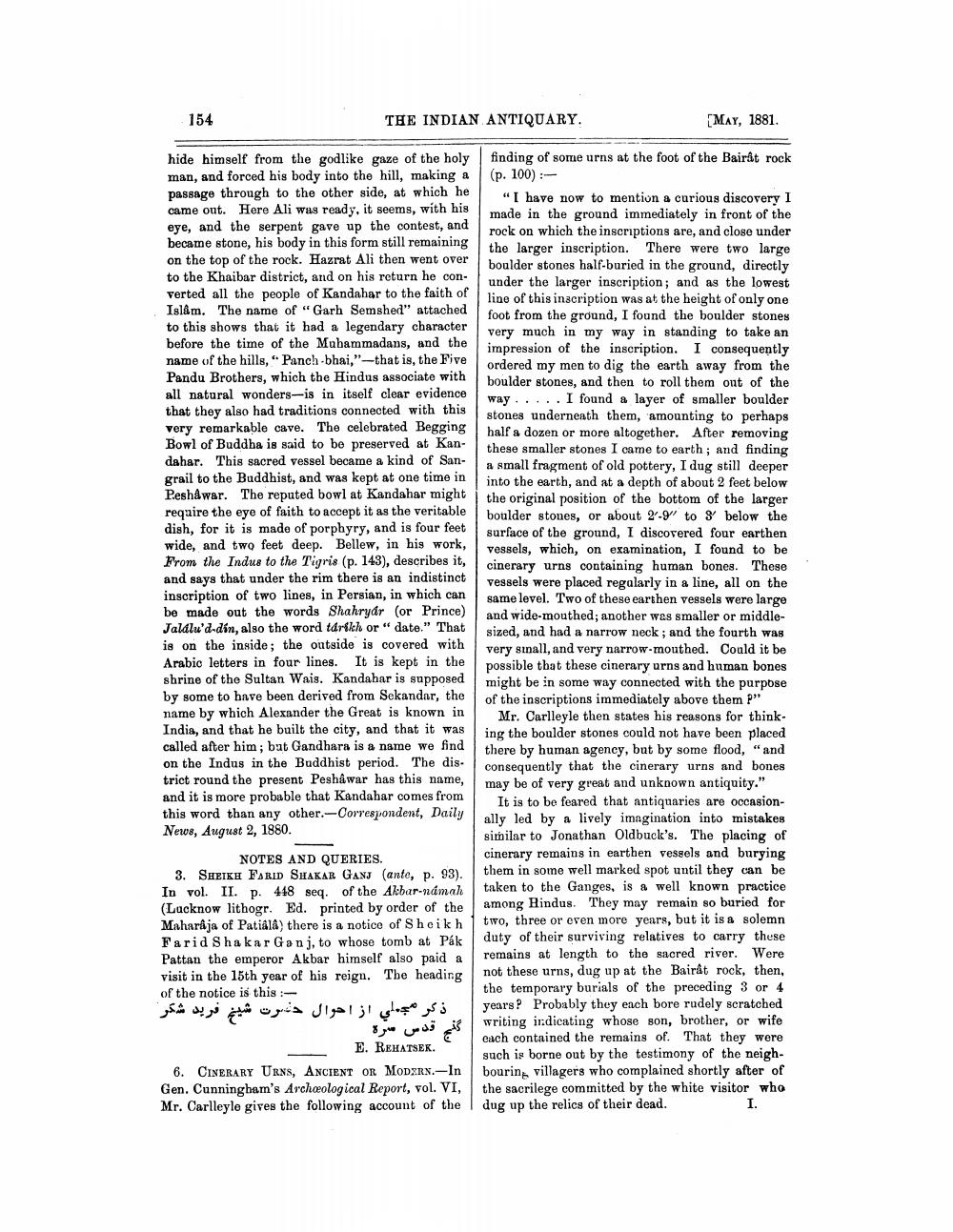________________
154
THE INDIAN ANTIQUARY.
[MAY, 1881.
hide himself from the godlike gaze of the holy finding of some urns at the foot of the Bairât rock man, and forced his body into the hill, making a (p. 100) :passage through to the other side, at which he
"I have now to mention a curious discovery I came out. Here Ali was ready, it seems, with his
made in the ground immediately in front of the eye, and the serpent gave up the contest, and
rock on which the inscriptions are, and close under became stone, his body in this form still remaining
the larger inscription. There were two large on the top of the rock. Hazrat Ali then went over
boulder stones half-buried in the ground, directly to the Khaibar district, and on his return he con
under the larger inscription; and as the lowest verted all the people of Kandahar to the faith of
line of this inscription was at the height of only one Islâm. The name of “Garh Semshed" attached
foot from the ground, I found the boulder stones to this shows that it had a legendary character
very much in my way in standing to take an before the time of the Mubammadans, and the
impression of the inscription. I consequently name of the hills, "Panch-bhai,”-that is, the Five
ordered my men to dig the earth away from the Pandu Brothers, which the Hindus associate with
boulder stones, and then to roll them out of the all natural wonders-is in itself clear evidence
way..... I found a layer of smaller boulder that they also had traditions connected with this
stones underneath them, amounting to perhaps very remarkable cave. The celebrated Begging
half a dozen or more altogether. After removing Bowl of Buddha is said to be preserved at Kan
these smaller stones I came to earth; and finding dahar. This sacred vessel became a kind of San- a small fragment of old pottery, I dug still deeper orail to the Buddhist, and was kept at one time in into the earth, and at a depth of about 2 feet below Peshawar. The reputed bowl at Kandahar might I the original position of the bottom of the larger require the eye of faith to accept it as the veritable
boulder stones, or about 2-9' to below the dish, for it is made of porphyry, and is four feet
surface of the ground, I discovered four earthen wide, and two feet deep. Bellew, in his work,
vessels, which, on examination, I found to be From the Indus to the Tigris (p. 143), describes it,
cinerary urns containing human bones. These and says that under the rim there is an indistinct
vessels were placed regalarly in a line, all on the inscription of two lines, in Persian, in which can
same level. Two of these earthen vessels were large be made out the words Shahryar (or Prince)
and wide-mouthed; another was smaller or middleJalálu'd-dín, also the word tarikh or "date." That
sized, and had a narrow neck; and the fourth was is on the inside; the outside is covered with
very sınall, and very narrow-mouthed. Could it be Arabic letters in four lines. It is kept in the
possible that these cinerary urns and human bones shrine of the Sultan Wais. Kandahar is supposed
might be in some way connected with the purpose by some to have been derived from Sekandar, the
of the inscriptions immediately above them P" name by which Alexander the Great is known in
Mr. Carlleyle then states his reasons for thinkIndia, and that he built the city, and that it was
ing the boulder stones could not have been placed called after him; bat Gandhara is a name we find
there by human agency, but by some flood, "and on the Indus in the Buddhist period. The dis
consequently that the cinerary urns and bones trict round the present Peshawar has this name,
may be of very great and unknown antiquity." and it is more probable that Kandahar comes from
It is to be feared that antiquaries are occasionthis word than any other.-Correspondent, Daily
ally led by a lively imagination into mistakes News, August 2, 1880.
similar to Jonathan Oldbuck's. The placing of NOTES AND QUERIES.
cinerary remains in earthen vessels and burying 3. SHEIKH FARID SHAKAR GANJ (ante, p. 93).
them in some well marked spot until they can be In vol. II. p. 418 seq. of the Akbar-námah
taken to the Ganges, is a well known practice (Lucknow lithogr. Ed. printed by order of the among Hindus. They may remain so buried for Maharaja of Patiala) there is a notice of Sheikh 1 two, three or even more years, but it is a solemn Farid Shakar Ganj, to whose tomb at Pák duty of their surviving relatives to carry these Pattan the emperor Akbar himself also paid a remains at length to the sacred river. Were visit in the 15th year of his reign. The heading not these urns, dug up at the Bairat rock, then, of the notice is this:
the temporary burials of the preceding 3 or 4 yearsP Probably they each bore rudely scratched writing indicating whose son, brother, or wife
cach contained the remains of. That they were E. REHATSEK.
such is borne out by the testimony of the neigh6. CINERARY URNS, ANCIENT OR MODxRN.-Inbouring villagers who complained shortly after of Gen. Cunningham's Archeological Report, vol. VI, the sacrilege committed by the white visitor who Mr. Carlleyle gives the following account of the dug up the relics of their dead.
ذكر مجهلي از احوال درت شیخ فرید شکر گنی قدس سره




